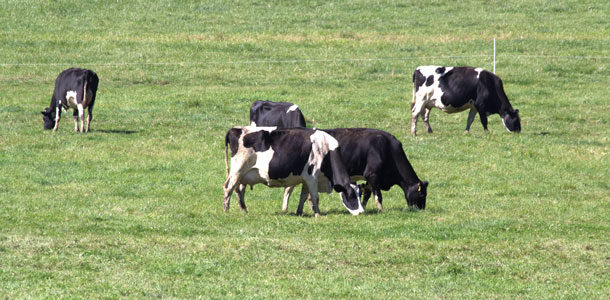Despite widespread use of continuous grazing on native grass rangelands, the practice has often been questioned for eastern pastures where we receive more than 40 inches of rainfall per year.
In these humid environments, rotational grazing is normally recommended for native grasses. The rapid growth, high yield and tall growth habit of these grasses make this a sound recommendation.
Growth habit is especially important with natives such as big bluestem, indiangrass and switchgrass. These tall-growing species all have a growing point – the structure within the lower stem from which leaf growth is initiated – that can be 8 inches or more above the ground by late spring.
In addition to the elevated growing points, these grasses produce only limited amounts of forage along the lower portions of the stem.
Grazing too closely will not only remove the growing point but can reduce leaf surface area to unacceptably low levels as well. Both of these outcomes will lead to periods of limited photosynthesis, increased demands on root reserves and weakened plants.
All of this can happen with shorter-growing species such as tall fescue and bermudagrass, but the height threshold at which it begins to occur is greater with natives.
Rotational grazing allows producers to avoid grazing too closely simply by moving animals from one pasture to the next. One rule of thumb often used is “take half, leave half.”
For instance, if you begin grazing a particular pasture when it is 26 inches tall and pull out at 13 inches, you will leave ample leaf surface area to maintain active growth, and the growing point will remain intact.
However, many producers do not routinely practice rotational grazing. Time constraints from off-farm employment or other responsibilities may not allow them to make these adjustments in a timely way.
So could they use some form of continuous grazing to manage native grasses? Results of a recent study conducted at the University of Tennessee suggest that the answer is “maybe.”
In this three-year study, steers were added and removed to or from pastures to adjust stocking as often as once per week based on grass condition.
Although this approach may not make sense for producers, it has the advantage in a research setting of allowing scientists to document carrying capacity over the course of the season.

Using this approach, the University of Tennessee study developed a growth curve for a big bluestem-indiangrass blend that provides a first-ever estimate of carrying capacity for this forage for the mid-South (Figure 1).
What is obvious from this figure is that carrying capacity does not stay consistent through the summer. It increases through late June, peaking at about 1,350 pounds of beef per acre, drops noticeably and stays level during late summer at about 1,150 to 1,200 pounds of beef per acre.
The average weight of a steer (750 pounds) and the average carrying capacity (1,194 pounds) over the course of the study worked out to having, on average, 1.5 steers per acre.
However, if this number of animals is maintained consistently on the pasture through the summer grazing season (red line, Figure 1), changes in actual carrying capacity would create problems.
In May, forage growth would outpace utilization (about 100 pounds per acre, Figure 1) and the situation would get worse in June (about 150 to 200 pounds per acre, Figure 1).
This lack of balance between animals and forage will result in the stand being overly mature in places and over-grazed in others. On the other hand, in late July, forage would not keep up with the demand of the growing animals (about 100 to 150 pounds per acre shortfall, Figure 1).
Another approach would be to stock more heavily, maybe at 25 percent above the 1.5-steer-per-acre baseline for the first half of the summer and then drop stocking to a level 25 percent below the baseline for the balance of the summer (green line, Figure 1).
Based on the experience in the University of Tennessee NWSG grazing trial, the date at which big bluestem-indiangrass would need to have stocking reduced is very close to June 25 every year (Week 10, Figure 1).
By using an earlier date for reducing stocking rates, a producer could adjust for over-grazing and provide some margin for error. Producer experience could also lead to some adjustment in the 25 percent increase/decrease in stocking rates.
This strategy takes advantage of peak growth periods and only requires one additional adjustment compared to season-long stocking. It also has the advantage of being able to remove larger animals in late June and move them into what historically has been an excellent time to sell cattle based on markets.
This approach is also similar to one used on native range in the Great Plains for many years. Although we have not tried this approach in trials to date, a pilot project is being conducted this summer at the University of Tennessee’s East Tennessee Research and Education Center to evaluate this approach to grazing big bluestem-indiangrass pastures.
With lowland switchgrass (Alamo), the challenge in managing productivity is considerably greater. This is because carrying capacity varies so much more over the summer – from 2,500 down to 1,100 pounds per acre (Figure 2).
Using a set number of animals for the whole season simply would not work.
For the lowland switchgrass, the average weight steer and average carrying capacity over the three-year University of Tennessee study worked out to, on average, 2.25 steers per acre.
Pasture growth in late May and June would rapidly outpace grazing if this stocking rate were used – by nearly 800 pounds per acre in June (red line, Figure 2).
Similarly, grazing would exceed growth at this same stocking rate late in the summer – by about 500 pounds per acre (Figure 2). Simply increasing (or reducing) the basic stocking rate would only compound the problem on one end or the other.
These figures also reveal that overall carrying capacity for switchgrass is about 50 percent greater than for the big bluestem blend – 2,500 versus 1,350 pounds per acre.
In addition, the difference from peak to late season would require a bigger shift in stocking rates at mid-season: 33 percent greater and 67 percent of the baseline, respectively (green line, Figure 2).
Additionally, switchgrass peaks about one week earlier in the season and stocking would need to be dropped closer to June 18 annually (Week 9, Figure 2). If an upland variety of switchgrass had been used, overall carrying capacity would have been lower and perhaps the magnitude of these shifts would have been less as well.
What is the take-home message here? Based on past experience, we think that simply making a single adjustment in late June to a bluestem-blend pasture may be a reasonable strategy.
For switchgrass, aligning stocking rates with carrying capacity will likely require more adjustments. For either of these forages, some form of rotational grazing can certainly work. It may be more important though for capturing the tremendous growth of switchgrass.
Another message might be that the decision on how to best graze natives is not strictly one of rotational versus continuous, but rather it lies in an adjustment that is somewhere between these two approaches.
Regardless of how you take advantage of either of these native grass forages, it is important to maintain vigorous canopies capable of supporting an equally vigorous root system.
As this summer’s research unfolds, we hope to see how a constant stocking rate compares to the “heavy early stocking” approach mentioned above for the big bluestem blend.











